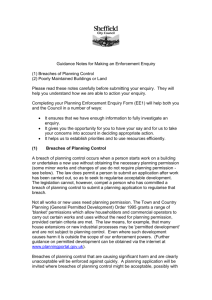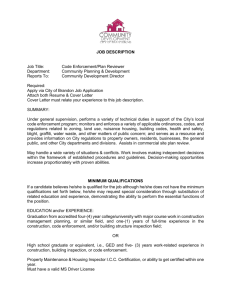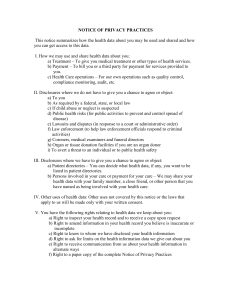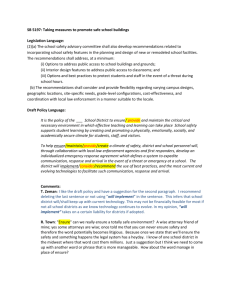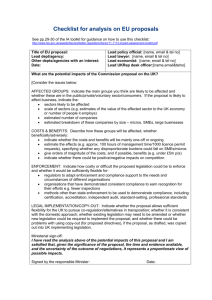LONDON BOROUGH OF RICHMOND DEVELOPMENT CONTROL
advertisement
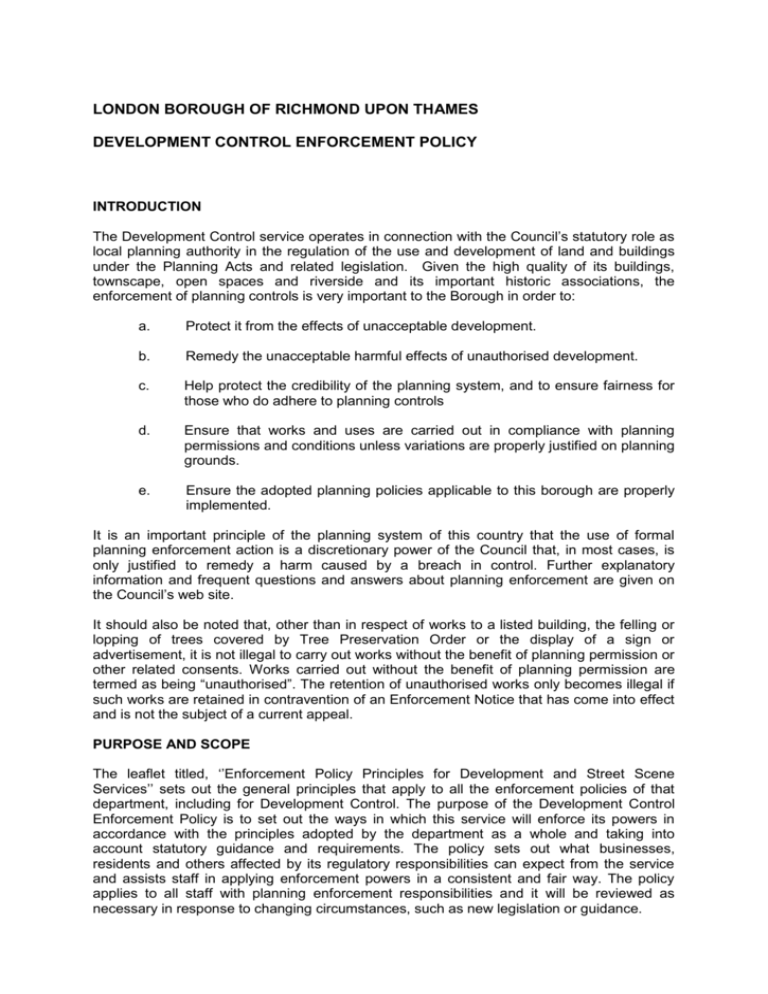
LONDON BOROUGH OF RICHMOND UPON THAMES DEVELOPMENT CONTROL ENFORCEMENT POLICY INTRODUCTION The Development Control service operates in connection with the Council’s statutory role as local planning authority in the regulation of the use and development of land and buildings under the Planning Acts and related legislation. Given the high quality of its buildings, townscape, open spaces and riverside and its important historic associations, the enforcement of planning controls is very important to the Borough in order to: a. Protect it from the effects of unacceptable development. b. Remedy the unacceptable harmful effects of unauthorised development. c. Help protect the credibility of the planning system, and to ensure fairness for those who do adhere to planning controls d. Ensure that works and uses are carried out in compliance with planning permissions and conditions unless variations are properly justified on planning grounds. e. Ensure the adopted planning policies applicable to this borough are properly implemented. It is an important principle of the planning system of this country that the use of formal planning enforcement action is a discretionary power of the Council that, in most cases, is only justified to remedy a harm caused by a breach in control. Further explanatory information and frequent questions and answers about planning enforcement are given on the Council’s web site. It should also be noted that, other than in respect of works to a listed building, the felling or lopping of trees covered by Tree Preservation Order or the display of a sign or advertisement, it is not illegal to carry out works without the benefit of planning permission or other related consents. Works carried out without the benefit of planning permission are termed as being “unauthorised”. The retention of unauthorised works only becomes illegal if such works are retained in contravention of an Enforcement Notice that has come into effect and is not the subject of a current appeal. PURPOSE AND SCOPE The leaflet titled, ‘’Enforcement Policy Principles for Development and Street Scene Services’’ sets out the general principles that apply to all the enforcement policies of that department, including for Development Control. The purpose of the Development Control Enforcement Policy is to set out the ways in which this service will enforce its powers in accordance with the principles adopted by the department as a whole and taking into account statutory guidance and requirements. The policy sets out what businesses, residents and others affected by its regulatory responsibilities can expect from the service and assists staff in applying enforcement powers in a consistent and fair way. The policy applies to all staff with planning enforcement responsibilities and it will be reviewed as necessary in response to changing circumstances, such as new legislation or guidance. SERVICE STANDARDS The basic standards of customer service are set out in the leaflet, ‘’Development Control – Our Service Standards’’ available from our offices and via the Council’s web site, (see ‘contacts and further information’ below). In regard to the enforcement part of the service, the general standards and procedures are set out below. INVESTIGATING ALLEGED BREACHES Not all building works, changes of use, demolitions, advertisement signs, or tree works require permission from the Council, as local planning authority. However, when they do, breaches in planning control regulations could include: Unauthorised building or change of use Works that significantly change a building or use from that granted permission. Unauthorised implementation of a development that has planning permission without complying with any conditions or limitations attached to that permission. Unauthorised display of a sign or advertisement. Unauthorised demolition of listed buildings or buildings in a conservation area. Unauthorised felling or lopping a tree that is the subject of a Tree Preservation Order, or protected by virtue of being within a Conservation Area. In addition to responding to complaints the service will carry out selected compliance inspections of approved developments and pro-active enforcement investigations where resources allow. Records will be maintained to show when and what works were inspected, the results of the inspection and any remedial action considered necessary. When a breach of planning regulations is discovered, officers will deal with these according to the general approach set out in the department’s overall enforcement policy leaflet, ‘’Enforcement Policy Principles for Development and Street Scene Services’’, and the following specific procedures and principles will also apply: From the Complainant’s point of View To initiate a planning enforcement investigation, complaints should normally be made in writing by letter, email or via the standard form provided on the Council’s web site. These should include the identity and address of the writer, the site address at which the alleged breach of planning control has taken place, a short description of what is alleged to be a breach of planning control and what is considered to be the harm caused by it. In exceptional circumstances, such as when emergency action is required, (see (iii) below), or when there is a special reason why writing is difficult or impossible, then investigations can be initiated by a telephoned call or personal visit to speak to the planning enforcement team. In respect of complaints received about alleged breaches the following service standards apply: 1. Written acknowledgement of requests for investigation within two working days. 2. Other than in cases where immediate or urgent action may be required, (see (3) below), carry out an initial investigation on possible breaches of planning control within four working days of receipt ensuring that any visiting officer produces identification. 3. In cases of reported breaches in planning control involving a serious and/or irreversible harm, the complaint will be investigated as a matter of priority as soon as possible, usually within the working day it is received, and urgent action will be instigated to stop the unlawful activity where harm being caused makes this appropriate. Examples of such urgent high priority cases are damage or demolition of listed buildings, buildings of townscape merit or buildings in conservation areas, damage to, or felling of protected trees, or any other cases where there is a serious and imminent danger of harm in planning policy terms that could not later be satisfactorily remedied. 4. Give the complainant information about how we will be dealing with complaint within 15 working days of receipt. The officer will clearly explain to the complainant whether a breach of planning control has occurred, whether or not it is considered expedient to instigate enforcement action and, if it is, the likely timescales involved to achieve a remedy. 5. Within 5 working days of a decision to take, or not take, formal enforcement action the complainant(s) will be informed of this in writing. 6. Confidentiality of a complaint’s identity will be safeguarded at investigation stage. 7. Information about enforcement complaints, including key stages of investigation will be made available to the public, including via the Council’s web site by April 2007. From the Contravener’s point of view. The usual approach before taking formal enforcement action is for the officer concerned to fully and openly discuss the circumstances of the breach and where possible resolve any points of difference. A warning will normally be given, (including a formal caution if the works carried out are potentially illegal), and a time period to comply with the legislation. In such cases written notice of the breach and the requirement to conform to the legislation will be given before any action is taken. However, this may not be possible if urgent or immediate enforcement action needs to be taken such as in the examples given in (3) above. When breaches appear to have occurred officers will: Communicate clearly to the responsible party or their agent identifying the problem and the measures that may need to be taken to achieve compliance. In the case of formal action being authorised the contravener’s rights of appeal will be explained to them. Where officer’s consider there is no significant planning harm or that harmful effects may be satisfactorily addressed by mitigation measures, allow a reasonable period for the submission of a retrospective planning application to regularise a breach of planning control. Where initial attempts to persuade the contravenor voluntarily to remedy the harmful effects of unauthorised development fails, negotiations will not hamper or delay whatever formal enforcement action may be required to make the development acceptable. Initiate formal enforcement powers given to local planning authorities when necessary, after being satisfied that there is a clear breach of planning control that would unacceptably affect public amenity or the existing use of land and buildings meriting protection in the public interest. Within 5 working days of a decision to take, or not take, formal enforcement action the contravener will be informed of this in writing. ENFORCEMENT OPTIONS Planning guidance and the principles of the Enforcement Concordat require officers to seek a voluntary resolution to a contravention whenever this is possible and appropriate. This does include officers advising the contravener, (without prejudice to any subsequent formal decision of the Council), that they could submit a retrospective planning application to retain or continue the unauthorised building/use if it appears at this stage that this may be acceptable to the Council. This approach does satisfactorily resolve many cases, with the contravener voluntarily rectifying harmful aspects of unauthorised development and/or obtaining retrospective planning permission. When it is not possible or appropriate to obtain a satisfactory voluntary resolution to a contravention and it is considered expedient to take formal enforcement action to rectify any harm that this causes, the main options for action are summarised as follows: Service of an Enforcement Notice that requires works or action to take place, or a use to cease, sufficient to remedy the harm caused by the breach. Service of a Breach of Condition Notice to require compliance with a planning condition. Where breaches are causing serious harm a Stop Notice may be served in conjunction with an enforcement notice to require a negative action such as ceasing work or a use. In terms of the requirements of the stop notice, an appeal against the enforcement notice does not suspend its effect pending the appeal decision and contravention of an enforcement notice gives a liability to immediate prosecution. An alternative means of taking relatively quick action in the case of a seriously harmful breach would be to seek an injunction. Service of a Temporary Stop Notice that has a similar effect to the above Stop Notice but is only effective for 28 days and does not have to be served in conjunction with an Enforcement Notice. Court action prosecution can be taken directly against unauthorised advertisements. Service of an ‘Untidy Site’ notice to require remedial works or clearance of rubbish etc. from sites or buildings that are in a state of serious untidiness or disrepair that is harmful to the appearance of an area. Although not a formal legal action, the service uses a ‘red card’ warning system for contraveners. This involves serving a notice whilst on site inspections on people who appear to be carrying out unlawful works or uses. It warns them in clear language that they appear to be contravening planning law and that if they proceed they do so at their own risk of subsequent formal enforcement action. PARTICULAR CUSTOMER NEEDS The service will endeavour to be flexible in responding to customer needs by adapting the method of operation to suit the customer. In particular, service leaflets, letters or other documents will be translated into other languages at no additional expense to customers utilising the Language Line Subscription Service. Arrangements will also be made for interpreters when this is necessary. CONTACTS AND FURTHER INFORMATION Our service provides a range of supplementary planning guidance, design guidelines, planning information and forms. These can be obtained by: Calling the Environment Contact Centre (08456 122660) Emailing planningenforcement@richmond.gov.uk Looking at our website www.richmond.gov.uk By writing to us or visiting us at Development Control Civic Centre 44 York Street Twickenham TW1 3BZ General enquires contact numbers Environment Contact Centre (08456 122660) Our Civic Centre has full access for disabled people and induction loops in the general reception area. If you need any help getting into the building, please let us know beforehand and we will make arrangements to help you If you need this leaflet in Braille, large print, audio tape, or another language, please contact us on 020 8891 7322 or minicom 020 8831 6001
